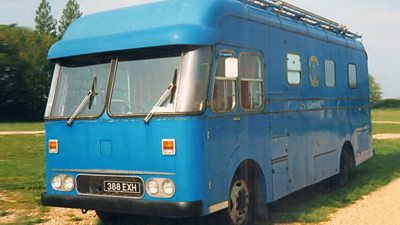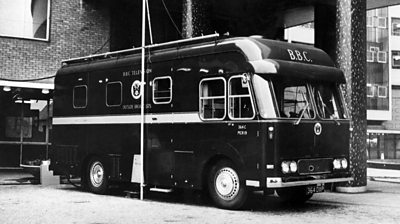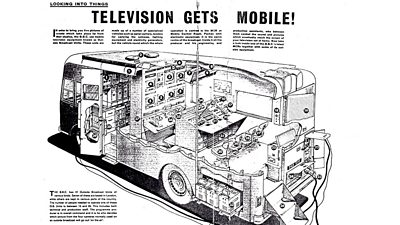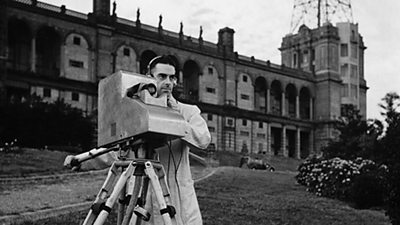1 July 2019 marked the 50th anniversary of the Investiture of the Prince of Wales at Caernarvon Castle. It was a TV milestone and involved an example of ����ý technology which half a century later has been saved for the nation. Charles Runcie tells its fascinating story.

It was to be the first royal event of its kind for nearly 60 years. It was to be held in the remote north Wales town of Caernarvon. It was a virtually made-for-TV production, devised and masterminded by the Queen’s brother-in-law Lord Snowdon. 28 cameras were used in the ����ý’s coverage of the Investiture that damp July day – and another small OB van was there too.
Caernarvon was another milestone for a ����ý Outside Broadcast production vehicle that had been used to help transmit at some of the most memorable UK events of the 1960’s. Having been sold, then rescued from a metal graveyard, it is now about to be reborn this year, being restored to its original glory.

Its history is the history of how TV developed in the 1960’s. As television in Britain became more expansive in that era, more outside broadcast capacity was needed. An outside broadcast vehicle, the 3rd of 10 commissioned from the Pye electronics firm by the ����ý, was ordered.
It was built on top of a Commer chassis by coachbuilders Marshall’s of Cambridge, equipped with 4 black and white cameras, and using Pye technology. Delivered in 1963, it was given the serial number “MCR21”, standing for Mobile Control Room then the number of the vehicle in the ����ý OB fleet.

MCR21 was based in London and used in coverage of many of the great events of that era like the funeral of Sir Winston Churchill, Wimbledon tennis and the British Grand Prix. It also a starring role at the 1966 World Cup, being situated at Wembley Stadium for all 6 of England matches.
Harry Coventry was the senior cameraman of MCR21 at the final on that warm July afternoon. "I was operating the close-up camera on the main rostrum as the game was ending" he remembers. "I had my close-up shot-on Geoff Hurst, but the director decided to stick with the wide shot camera as the ball was kicked up the field for Geoff Hurst to run onto and score. I did get my shot used, but sadly not until afterwards. I managed to get a DVD from the ����ý of my own shot of the goal, though!"
MCR21 was eventually converted to 2-camera colour use in the late 1960's, just in time to be part of the ����ý’s coverage of the investiture in the summer of 1969. The whole production was an amazing effort for the ����ý, says broadcast technology historian Nick Gilbey. "Mobile camera units CMCR 4 and 5 covered the ceremony, while CMCR 6 was deployed in the town.
Meanwhile MCR21 was positioned at the railway station to cover the arrival of the Queen and Prince Charles. It was the first major event of its type televised in colour and broadcast by the ����ý at that time, with colour only having reached our screens a year or so previously. ITV had also broadcast the event, but only in black and white!".

MCR21 worked on through the 1970’s, but with the rapid pace of technological development it was eventually declared redundant by the ����ý and put up for sale in 1979. Radio amateur enthusiast Brian Summers, who also had an interest in electronics, spotted and bought it for “its metal value, small hundreds of pounds.
It had its mixer still in there but had been stripped of everything else the ����ý could reuse” recalls Brian. "By the early 80’s I had bought back some of the original equipment for it and showed the vehicle off at TV technology clubs and demos. However a busy working life with the ����ý meant that by the 1990’s it had become neglected, sitting in my drive at home".
On retirement Brian decided to decide to strip, renovate and restore it back to its original 1963 appearance. He set up a trust with Gilbey and other technology enthusiasts, to help preserve its ownership for the future. A recent successful bid to the National Lottery Heritage Fund for £99,000 meant the hard work would now be able to start.
"The group would like to acquire more historic equipment to install in MCR21, such as one of the only 3 surviving black and white cameras for that type of vehicle still known to be in existence, and work with the original 10 channel mixing desk for its 4 cameras. The hope is it will once again become a working outside broadcast vehicle, to be used for demonstrating and promoting the history of television technology at small events and shows".

The official launch of the project will take place at , near Arundel, West Sussex, over the weekend of 17/18 August 2019. For MCR21 it will be the start of a brand-new era over 55 years after the start of its life at the ����ý.
Find out more
-
Find out more about the most original and complete example of a ����ý Monochrome OB van.
Read more about outside broadcasts
-

50 Years of ����ý TV Colour
Amanda Murphy tells the story of how the ADAPT TV project reunited a pioneering television crew 50 years after the first colour outside broadcast. -

MCR21 comes back to life
Charles Runcie tells the story of a group of enthusiasts who saved a 1960s ����ý outside broadcast van from the scrapheap -

The First Outside Broadcast
People involved with the ����ý's early experiments with outside broadcasting recall their memories for the ����ý Oral History Project -

Working on the London 1948 Olympic Games
Producers, camera operators, and others recall how they coped with a tiny budget and pre-war equipment to broadcast the 1948 Olympics.

